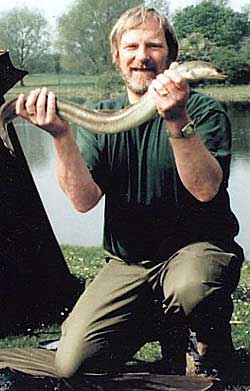I am currently researching the life cycles of the freshwater eels, Anguillaanguilla and Anguilla rostrata. I would like to substantiate or repudiatethe claims made in many scientific studies that mature freshwater eelstravel overland from inland lakes and ponds in order to find their way backto the sea and that elvers adopt a similar mode in order to initially findfreshwater. I would be grateful for your assistance.
I have been fortunate on one occasion to witness what may have been a massinvasion of elvers overland. The elvers appeared to be making their way up awet boggy field during a rainstorm. The event took place in North Wales,adjacent to a storm beach and well away from a river or any other source offresh water. I have no idea where they were heading or indeed whether or notany of them actually made it to freshwater. It seemed clear to me that theymust have simply left the sea over the stony beach just a few hundredmetres away. Even though I searched the shoreline, I did not see any elversthere, but hundreds of them were in the wet grass, squirming their way up tothe top of a gentle incline. It had rained persistently for some days andthe field was waterlogged. Elvers inhabited every puddle, which had formed inthe depressions caused by cattle hooves or tractor tracks. It seemed to methat they must have all come ashore together. It was possible I suppose,that the elvers had been cast up onto the beach during high tide by aparticularly powerful wave, however, on the day in question, the sea wasquite calm. Unfortunately I have no recollection of the wind strength andsea state on the days preceding this event. The chances of any of those elvers reaching freshwater somewhere is onfirst inspection, remote. It is understood that elvers usually enterfreshwater via an estuary and then along a river, into a stream or ditch andfinally into a pond or lake via an underground spring, (or through loosegravel or shale and on into a lake or pond). It is certain that many inlandlakes and ponds do not have any visible connecting water source or overflow,but they do hold a quantity of mature eels, and of course, they had toarrive there somehow. I therefore accept that elvers can and do find theirway to inland stagnant freshwater habitats but I am not entirely convincedthat a mature eel could leave such an environment and travel very faroverland without being spotted and eaten by bird or predatory mammal. A mature eel is of a greater size compared to an elver. Like elvers, theycould use overflow ditches and drains before reaching major rivers, but forthose eels that would have to take the overland trail before reaching such aditch, one would expect them to be fairly frequently observed! I have spent a great deal of time in and around the countryside yet I havenever seen an adult eel outside of its natural environment clearly migratingtowards a watercourse. Furthermore, I have never met anyone who claims tohave witnessed such an event either. If an eel is placed on wet grass, it is instantly apparent that its form oflocomotion is not particularly efficient. In order to move at all, the eelhas to perform energy-sapping gyrations that would attract the eyes and earsof any predator. Would predators such as badgers, foxes and otters know ofthe times when eels can be expected. Do eels form part of their diets duringsuch times? Surely any large eels making an overland journey across fallenrustling autumn leaves are likely to be spotted somewhere along the routeand be widely reported? I do know that when the mature eels start to migrate, they do so en masse soto speak, and many of our larger river courses trap a vast number for thecommercial markets at this time. I also accept that these eels have joinedforces with eels from many other waters, and not all of the eels from oneparticular water will leave it at the same time. It is also held that migrating eels do not feed since their digestivesystems cease functioning. Is this so? If it is so, why then are vast numbers of silver eels caught by seafishermen on baited hooks during the spring, before the traditionalmigrating period? Do some eels remain in the sea all their lives or are these actuallymigrating eels which are indeed feeding? Is there any clear, indisputable evidence, that European eels actually doreturn to the Sargasso to breed? I would be extremely grateful to anyone for any comments or scientific evidencethat you can point me towards regarding my study. Yours sincerely, Kevin Thornton |
Welcome!Log into your account











